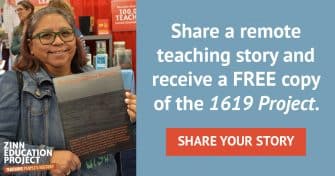 Teachers who share a story about how they taught one or more Zinn Education Project lesson remotely can receive a free copy of the New York Times’ 1619 Project.
Teachers who share a story about how they taught one or more Zinn Education Project lesson remotely can receive a free copy of the New York Times’ 1619 Project.
If you want to take advantage of the offer but haven’t yet used a people’s history lesson online, start with the guide by Ursula Wolfe-Rocca, “Teaching ZEP Lessons Remotely: Recommitting to the Why — If Not the How — of Our Pedagogy“:
Our lessons — trials, role plays, reading, writing, viewing, and discussion activities — have at their heart a belief that students should be given opportunities to interject themselves into history, to comment and act on, not just passively receive, the past and the present. The tools — whether pencil and paper, a Zoom breakout room, or a Flipgrid video — that best safeguard those democratic opportunities are the ones we recommend.
A number of Zinn Education Project lessons include Google Drive handouts ready for teachers to copy and share online with their students.
To qualify, please submit 3-5 paragraphs about your synchronous or asynchronous online teaching experience with any lesson found on our website. Explain what lesson you used, why you chose it, how your students reacted (student quotes are wonderful), and why you would recommend it to other teachers. Please include a photo of yourself or of your students’ work, if possible. You can see examples here.







We have formed a homeschool pod with a few families and are having weekly history club meetings via zoom with 6, 7th grade boys. Each week they are reading through chapters of the young readers peoples history of the United States and leading a discussion group focusing on the significance of events and questioning why some events may of not been taught to them previously. As us parents take the back seat we have been proud to watch the boys take ownership of learning a more inclusive history of our country.